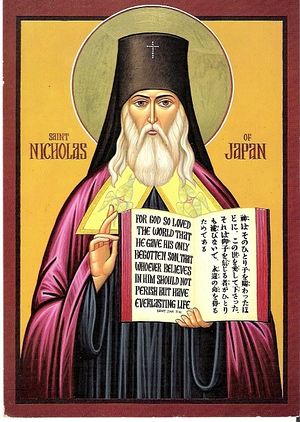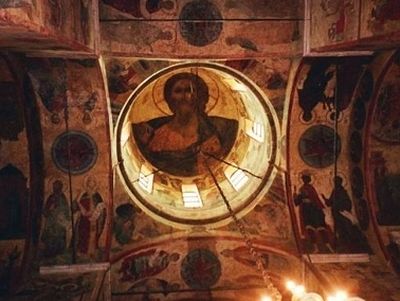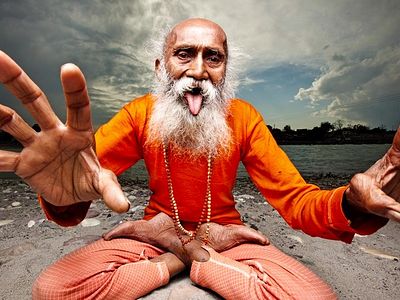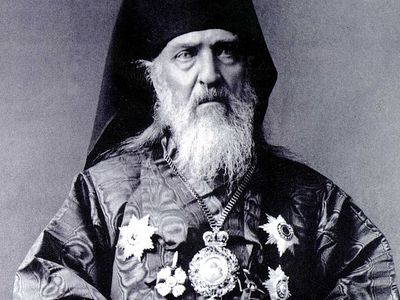Continued from Part 1
Excerpts from his diary supplement our understanding of how St. Nicholas related to Buddhism. Here observations are also marked by the fact that they were made by a practicing missionary.
Thus it is with, for example, the theme of the Buddhist priests’ resistance against Christianity. The saint calls them outright “enemies of Orthodoxy”, who “do not miss any opportunity to take advantage of existing circumstances in order to trouble the Orthodox and weaken Orthodoxy—which, however, they have thus far not been able to do.”[1]
“In their sermons, the bonza revile Christianity with all their might, but through this they are only showing their own confusion, and that they do no know what to do” (II, 205). The catechist “Paul Okamura related that bonza in plainclothes often come to him asking about Christianity, but then only use the knowledge they gather to pervert it and make it food for derision. Around [catechist] Matsuda the bonza have formed regular gatherings, always unbearably blaspheming against Christianity and forbidding others to listen to him. This, according to Matsuda, brings the exact opposite result: it only arouses people’s curiosity and they come to ask about Christianity” (II, 223).
It is worth noting that the holy hierarch was never perturbed by these displays of aggression from Buddhism, and considered it a sign of Buddhism’s inner weakness in the face of Christianity. He writes, “In Ebishima, an especially strong hatred against Christianity was aroused, and a society was even formed to defend Buddhism against Christianity; but this is only a sign that Christ’s teaching is beginning to more deeply occupy the people’s attention. As a counterweight there are no few pagans who, not yet even knowing about Christianity, become defenders of it against angry attacks” (III, 383). “In Nakatsu … the bonza were very troubled by the success of Christianity—they formed a union against Christianity, give sermons and revile it. Just in time! There are working for the good of Christianity by popularizing it; Buddhism has no defense against it” (IV, 31). And truly, soon the news came from Nakatsu of converts to Orthodoxy, “one of whom was a sworn Buddhist, and now he is an equally zealous Christian” (IV, 65).
On his own part, St. Nicholas instructed his catechists “not to insult Buddhism or other local faiths in sermons” (II, 393). Another time he reproached a catechist: “Matsunaga was not right to speak against Buddhism and insult it; we shouldn’t do that in our sermons. It is our business to instruct in the Christian teaching. When it will become understood, then Buddhism will be renounced by itself. Arguing against it too early will only close the path to Christianity in the hearts of many listeners, anger them and provoke them to fight it” (II, 600).
He describes how “in the Buddhist newpaper Yamato-Simbun, two articles are printed daily with the most impudent lies and slander against the mission and Orthodox Christians… We never answer these attacks” (IV, 907). During the Russo-Japanese War, the “Buddhist bonza, under the cover of military patriotism, began a persecution against the Orthodox Church… former or plainclothes bonza gave rousing speeches against me and the mission in rallies specially organized for this purpose” (V, 8).
This activity was not limited to verbal attacks. The saint cites examples of Buddhists physically attacking Christians with pogroms and beatings in Shirankava (see: II, 787), and also during the Russo-Japanese war in Kayama for the Christians’ refusal to participate in Buddhist prayers for Japanese victory (see: V, 62). Another time, local Buddhists confiscated land from the Orthodox and offered to return it to them only if they return to Buddhism (see: II, 484-484). He recalls one incident that happened to Peter Osida, formerly a Buddhism priest, who endured “persecution from his former parishioners for betraying Buddhism, but bore it steadfastly” (IV, 221). In Sukava two Buddhist fathers beat and tormented their own sons who had decided to receive Orthodoxy, but the latter showed great courage. About this the saint noted, “The fathers of the persecuted will soon also be Christians. This is something borne out by experience. Where Christ has come up against Buddha to the point of a noise that sounds like a shout, listen, and you will hear in the following moment not a shout, but the crash of the idol of Buddha shattering into pieces” (IV, 50).
Many times the saint recalls the low moral image of the Buddhist clergy in Japan. One wealthy farmer told St. Nicholas that, “he has come to hate the bonza who collect money for religious needs, and drink away half of it in houses of ill repute” (IV, 506). He also incidentally cites examples of bonza who attract people by their ascetic lives” (II, 351).
St. Nicholas writes that, as opposed to Confucianism and Shintoism, Buddhism still has sincere followers in Japan; however, he noticed signs of decline, especially against the background of the spread of materialism, and he considered that the time of Buddhism in the country had passed. “It is falling; apparently it has completed its service and it’s time for it to step aside” (II, 28). “Buddhists have no sturdy foundation for faith, there is no one there for them to believe in; that is why Buddhists are in decline” (III, 222). Another time, commenting on the Buddhist’s initiative for the creation of clubs to support their teaching, he notes: “But Buddhism nevertheless remains a corpse, and it can’t be revived by any means when the dawn of Christianity has come to Japan” (III, 801).
In an interview with a Japanese newspaper the saint continues this thought, answering the journalist’s question: “Buddhism is in a revival. How do you view this?” His answer: “As any other blustery talk. Buddhism has died in Japan; the Japanese have outgrown this religion without a Personal God; in vain do they interpret that it is still alive and is being aroused to energetic action. This is the empty boastfulness of the bonza, who don’t believe what they themselves say” (IV, 641). “Buddhism has reached the final absurdity in Japan, a diametrical contradiction of itself, and is easily refuted based upon the simplest rationale of common sense” (IV, 705).
It is worth noting that the processes negative to Buddhism in Japanese society forecasted by St. Nicholas really have intensified in the twentieth and twenty-first centuries, and publications in the modern press testify to this. For example, the author of one article cites the words of monks about how “Buddhism is now experiencing a crisis in Japan”, and decisive measures must be taken to ensure its survival. Monk Tansho Tagai proposed that one of these measures be the reading of mantras set to modern music, while Monk Zensin talks about the creation of Buddhist bars.[2] Another article talks about the crisis in Buddhism, telling the story of Monk Keisuk Matsumoto, rector of the Komiodzi temple, where he has opened a café to draw people in. It is noted that although nearly three quarters of the population formally considers itself Buddhist, “Many of the 75 thousand Japanese temples are on the brink of bankruptcy.”[3]
St. Nicholas touched upon the activity of Buddhism in other countries; for example, in describing the Boxer uprising in China he writes with a certain irony that the Buddhists “have extracted for their religion from the Chinese complications all the capital that could have possibly been extracted. They have left only one question unanswered, and that is: Were the boxers Buddhists? If yes, then how does Buddhism avoid responsibility for their outrageous cruelty?” (IV, 491). At the same time he expresses great respect for the steadfastness of the Chinese Christians, who died as martyrs for Christ during this uprising.
The saint also knew of the nascent Buddhist proselytism among Western peoples: “There are also bonza in San Francisco who preach Buddhism, and there are a few American converts. Temples have been built on the Hawaiian Islands; the bonza there copy the Christian missionaries—they have services and sermons on Sundays, and do charity work” (IV, 459). Here we see the same missionary flexibility in Buddhism that St. Nicholas noticed in relation to its spread in Japan.
St. Nicholas recalls also “Otani Kozui, the head of the Buddhist sect “Nishi Honganji. “He was educated in England… currently the best person in Buddhism by his morality and activity; he sends missionaries to preach Buddhism in Christian countries, and in America there are already many converts to Buddhism” (V, 499). He writes that in Ninai “The bonza … catechize the locals with the preaching that, “As soon as a foreigner appears here, convert him to Buddhism, because what is Christianity compared to Buddhism!” (IV, 120).
Notable is the history of the attempt to convert the Ain, an aboriginal people from the Kuril Islands who had received Orthodoxy from St. Innocent of Alaska when the islands were part of the Russian Empire (they were given to Japan in 1855) (see: IV, 79, 174, 283). A bonza settled from Honganji to Shikotan island with the aim of proselytizing. From 1899 to 1902, he put great effort into preaching Buddhism to the Orthodox Kurillians, with the support of the local authorities who considered this important for cutting off any possible influence from Russia on these local people. The preacher put maximum effort into adapting his teaching to the audience, using the same methods that helped Buddhism penetrate and take hold in Japan. “James related how the bonza, still living on Sikotan, try to confuse the Sikotan Christians and lure them into Buddhism: ‘Your God and our God are one and the same, but you are now Japanese, and therefore it is decent for you to have the Japanese faith, which is almost the same as your current faith,’ he insists to them. Fortunately, the Sikotan people are not ignorant in their faith and there souls are loyal to it. They only laugh at the bonza” (IV, 353).
Three years of preaching by the Buddhist missionary did not convert a single person, and after this the “bonza, having found their efforts to turn our Christian (Kurillians) to Buddhism to be completely fruitless, left for Saykeo” (IV, 701).
Meanwhile, St. Nicholas knew of the Europeans and Americans who recieved Buddhism. He recalled the Englishman who died in Japan having converted to Zen Buddhism as a “forever unhappy renegade” (V, 348), and the American, Fenolossa, who became a Buddhist (see: V, 595). He sharply reacted to General Henry Olcott, “who converted to Buddhism and even composed a Buddhist catechesis” (III, 560). All of this seemed to the saint ridiculous in the highest degree. Noting the closeness of Schopenhauer’s philosophy to Buddhism, St. Nicholas theorized that, including through it, “Buddhism entered through the edge of its mist into certain empty heads in Europe and America” (II, 304).
In different notes he points out that, firstly, in turning toward people in the West, Buddhism itself mimics in many ways the Christian milieu; and on the other hand, the new converts themselves introduce into Buddhism ideas and concepts that are alien to it. In this sense, noteworthy are St. Nicholas’s comments on the book by one of the more well-known European preachers of Buddhism of the time: “Ambassador Mikhail Alexandrovich Khitrovo came with a German catechism of Buddhism… The author is a German who placed himself among the ranks of the fans of pantheistic Buddhism, but at the same time he cannot renounce the belief he received with his mother’s milk in a Personal God, and that is why he talks in his catechism about a power that rules the world that excludes accidents in the world, at which our Mikhail Alexandrovich, partially besotted with Buddhism, replied in the margins, “Fool!” (III, 229).
St. Nicholas is apparently referring to the book, Subhadra Bhikchu Buddhistischer Katechismus zur Einfuhrung in die Lehre des Buddha Gotamo (Leipzig, 1888), written in emulation of the Buddhist Catechism of Olcott. Behind the pseudonym of Monk Subhadra hid the Berlin mathematician Fredrich Zimmerman (1852-1917).[4]
The saint just as negatively reacted to the idea he heard of creating a hybrid of Christianity and Buddhism, pointing out the “absurdity of such an endeavor, and the impossibility under any circumstances of comparing the truth of God’s faith with human invention” (III, 363).
St. Nicholas approved of the words of his visitors who “had compared Christianity with Buddhism and found them to be polar opposites” (III, 804). The saint at times had to disprove the then popular opinion among Western and Russian intelligentsia that Christianity was constructed upon ideas borrowed from Buddhism. He describes his conversation with the wife of Admiral Schmidt. At her remark about the closeness of Buddhism’s moral teaching with that of Christianity, St. Nicholas replied, “ ‘There is indeed some resemblance to our religion in Buddhism’s moral teaching; and what pagan religion does not have it? The moral teaching of pagans is drawn from the conscience, which they have not lost.’ ‘But they say that Christ’s teachings were borrowed from Buddhism.’ ‘Well, this is what people say who know neither Buddhist nor Christian teachings well.’ ‘No—why shouldn’t Christ borrow something from Buddhism if He liked it? He (Christ) was an intelligent man.’ ‘Christ was God and He spoke His teaching as a Divine command; Buddha, as well as everything in the world and the whole world itself, is nothing before Him’, I interrupted her, in order to stop this outflow of refuse from the cesspool of a general’s mind… So, the upper class in Russia is ignorant … in things related to faith” (II, 296).
At the same time, the saint also related skeptically to ideas expressed in response apologetics about aspects in the life of Buddha supposedly being borrowed from the Gospels. Remarking on a lecture he heard by the Protestant Spencer, St. Nicholas writes that there were “no few paradoxes; for example, the supposition that Buddha’s ‘life’ was copied from the life of the Savior. He would do well to prove that” (IV, 167).
From conversations with converts, St. Nicholas formed the opinion that Buddhism does not answer the needs of the soul that has a living religious feeling. He cites the story of one family: “Yuki and his wife were both believing Buddhists. Not having found in Buddhism a ‘personal’ God, he lost his faith in it and was extremely glad to find God the Creator and His Providence in Christianity, about which he had learned by accident, having obtained a Bible. He began to pray to the Christian God, and his fervent prayer was even crowned by a miracle: his wife had been ill to the point that she was unable to stand up. He prayed fervently for her healing, and she at once rose up healthy, to everyone’s amazement” (IV, 208). It is the fact that Christianity gives a person not simply an “idea of God”, but a living connection with Him, that in St. Nicholas’s eyes distinguishes it in principle from Buddhism. This is explained by the saint’s comment that, “Buddhism in the religious sense is essentially empty, for what religion can there be without God?” (III, 443).
St. Nicholas spoke several times about Buddhist prayer: “Their prayer is fruitless, because they pray to something that does not exist” (V, 571); “Their prayer is useless and deserves pity, for a tree and a rock or some empty space, at which they direct their calls to the gods and buddhas, which do not exist, do not see or hear them, and cannot help” (II, 175).
Unfortunately, St. Nicholas (Kasatkin’s) study of Japanese Buddhism has remained completely unnoticed by Orthodox authors, although it could substantially supplement their knowledge of the many various trends in this religion. The first attention given to St. Nicholas’s views on Buddhism came as late as the twenty-first century: A. Larionov in a short article gave an overview of the saint’s commentary, almost entirely based upon his Diaries.[5] He writes that the “comments on Buddhism are rare, and bear a purely practically character. The basic conclusion is: Buddhism had for a long time fulfilled its role as nanny, preparing the Japanese to receive the Truth… This was that “divination in the mirror”, which taught the Japanese love for each other and an understanding of the vanity of life. Now it must be set aside, because the fullness of grace has come.”[6]




